It is always exciting to look into the crystal ball, and the display industry is moving forward at an amazing pace in these years. In this article, FlatpanelsHD takes a look at the 5 most promising display technologies of the near-term future. We also take a look at the display technologies that could reshape the industry in the long run and the display technologies that flopped.
1. OLED
It is hard to ignore OLED in this context. We already have OLED displays in our small, handheld devices but OLED technology has so much potential that it could change the entire display industry over the next few years. OLED is not only a promise of "faster, better and thinner"; OLED technology can also open up entirely new markets and enable manufacturers to create product categories that we cannot even imagine yet.
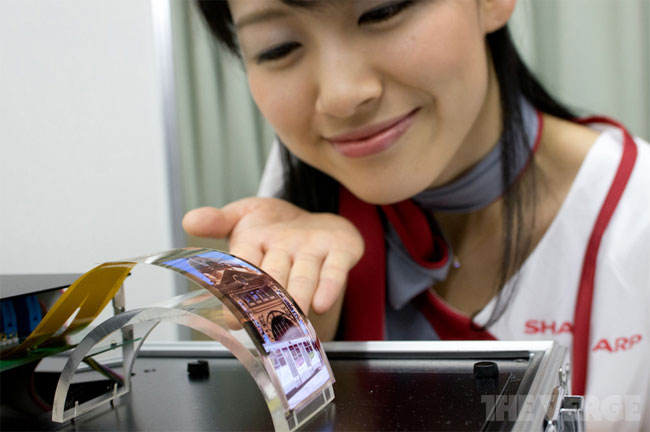
OLED displays can become paper thin and flexible. Here you see one of Sharp’s prototypes. Picture credit: The Verge
Within the next few years OLED technology will make it into our living room TVs, after having started with the smartphone and tablet arenas. OLED displays can become extremely thin, transparent and even bendable which will undoubtedly change our perception of display technology. OLED could make it into for example window glass or into textiles. OLED displays can become extremely rigid,too, and even serve as a light source in for example lamps – or just lighting mounted directly onto the wall or ceiling.
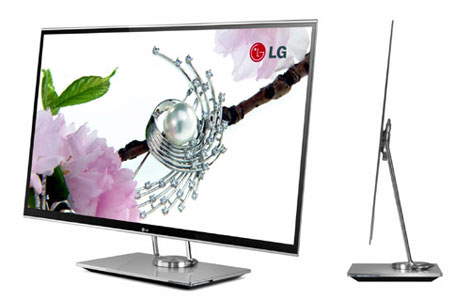
LG 31” OLED-TV
Every major display manufacturer is researching OLED technology and analysts estimate that the OLED market will explode in the next 5-10 years. OLED has no inherent limitations to size and resolutions either, so it can even help enable gigantic living room TVs.
Learn more about OLED in our OLED section.
2. Tactile/Haptic touch
Last time when FlatpanelsHD tried to predict the future of display technology, we said that touch technology would reshape the display industry. Today it has. Touch screens have grown from zero to everything in smartphones and tablets in a very short time period. It is almost impossible to find a phone today without a touch screen and it is hard to comprehend that all this started just 5 years ago when the first iPhone launched with capacitive touch technology and multi-touch. 5 years…

Tactile screens can imitate different surface structures on the panel, picture credit: CNET
So it is also natural to think about where touch technology goes from here. One of the most promising next steps is tactile – or haptic – technology. In a tactile touch screen you add a separate layer that can provide feedback to your fingers when touched. In other words; it can imitate physical buttons and textures dynamically on the screen surface; for example sandpaper or dirt. It happens dynamically and the device can make buttons or surface textures pop up and go away everywhere on the screen. For example, when you need a keyboard the screen can imitate physical keyboard buttons. Think about it. You can have buttons in tablet games that feels like real buttons – you can even feel the internet. Mindboggling.
Tactile display technology is fairly mature already but we have not seen it adopted in any significant way so far. The obvious candidates are of course smartphones and tablets but tactile technology can also solve some of the most criticized elements of touch screens today; that they cannot be operated without looking. This could mean that touch screen TV remotes could become useful.
Learn more about touch screen technology here.
3. Higher pixel density
Smartphones and tablets have taken the lead in this trend, and higher resolutions are coming to your TVs and computer monitors, too. However, resolution is an absolute term and the modern would instead refers to “pixel density” – measured in ppi (pixels per inch) – when trying to explain the more detailed displays in our devices.
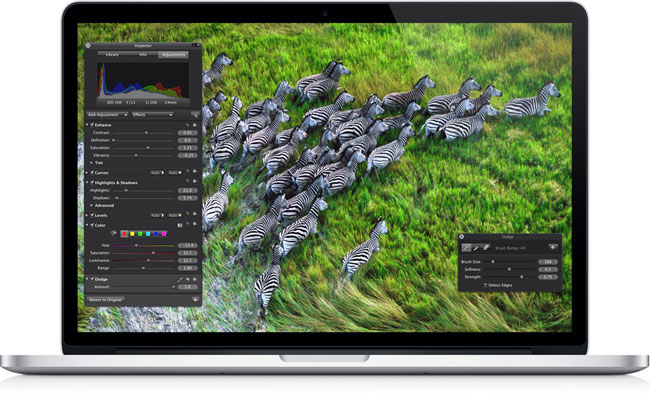
The new Macbook Pros have a Retina display
4K Ultra HD TVs are coming and the first laptops with extremely high pixel density are also out. Within the next few years, we predict that the rest of the industry will take part in the pixel race. And that is a good thing. But what is it exactly that enables higher resolution? And why has it not been possible in the past?

The more pixels the harder it is to discern pixels – which means more detailed text and elements on the screen
Higher pixel density is dependent on smaller transistors. Transistors exist in all display panels and supply each individual pixel with an individual voltage level. Sharp’s IGZO technology is an example of a display substrate that can enable much smaller and faster transistors, thus displays with higher pixel density. The really interesting part is that transistor technology not only benefits LCD panels but also plasma and OLED displays. That is why this is much more important than most people believe.
The trend towards higher-resolution displays is evident in pretty much every segment of the display industry. Within a few years even our PC monitors and TVs will benefit and take picture quality to a new level – even though resolution is not the only factor in great picture quality, obviously.
4. Virtual Reality & augmented reality
Virtual reality and augmented reality have some common features but should also be considered separate concepts. Virtual reality is a “virtual” world – for example games and movies – and augmented reality is a concept where you add “layers” of visual information on top of our real world. Both visions involve display technology of some kind.
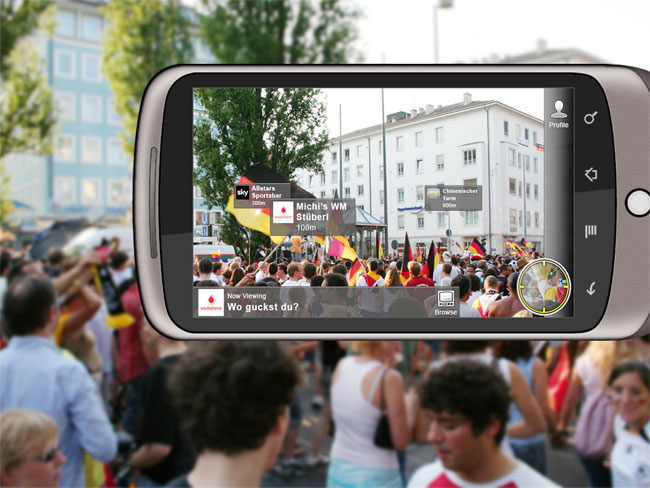
Augmented reality apps for smartphones already exist and can add layers of information on top of the real world. In the future it might happen right in front of your eye
One of the most recognized augmented reality projects right now is Google’s Project Glass where a small device projects visual information onto the user’s eye. Google Glass is not an actual screen but rather a mini projector that sits in front of the eye. Imagine the possibilities. For example, say you want find the nearest Starbucks. You could input this into the system and the augmented reality system would guide you with arrows right in front of your vision as you walk. This is indeed “augmented” reality. Apps for smartphones already exist as seen in the image above. One example is Layar.
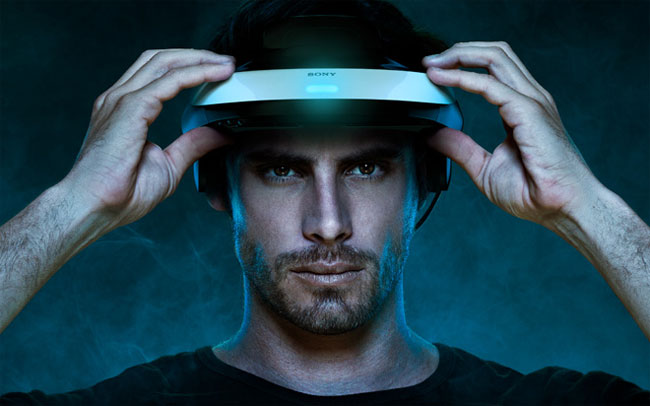
Sony has launched the Virtual Reality product, HMZ-T1
Virtual reality on the other hand is far more gaming and movie-centric. It aims to take users into virtual worlds and has always followed the evolution of display technology. You probably remember some of the virtual reality projects from the nineties that failed big time. That was then. Interest in virtual reality has returned, and the technologies have been much improved. For example, OLED displays could make Virtual Reality a success. These paper-thin and curved OLED displays could provide a completely immersive experience when playing games or watching movies. Combine that with 3D and you can create ultra-realistic game worlds – at least that is the vision.
We recently reviewed Sony's Personal 3D Viewer and took a look at Carl Zeiss’ Cinemizer but there is much more potential in Virtual Reality. We look more closely at the latest development in this this article. This time is could actually work.
5. Glasses-free 3D
3D TVs that require 3D glasses became the talk of the town after Avatar hit the cinemas. Since then, interest in 3D has fallen of a cliff. Viewers have no interest in wearing stupid 3D glasses while sitting in the living room sofa with friends and family.

Toshibas has launched the first glasses-free 3DTV but the technology is still not ready for the mass market
3D is not dead but consumers and manufacturers have already turned their attention to glasses-free 3D displays. FlatpanelsHD has said it before and will continue to say it. Glasses-free 3D technology is not around the corner. It will take many years to commercialize. Yes, we know that some manufacturers have consumer products available but there are extremely expensive and not very good. Toshiba launched their first glasses-55" 3DTV in 2011 but the technology has inherent limitations that degrade the 3D effect and affects 3D picture quality negatively. The technology does not differ significantly from the small 3D cards included in cereal boxes and we simply need a more sophisticated technology in order to have glasses-free 3D technology reach the mass-market.
So what could help us? Well, glasses-free 3D is driven by development in a number of areas, including OLED technology and high-resolution displays. Both are described in this article. The upside? When – or if – glasses-free 3D TVs materialize then for once we can say that we have lots of content. That must be a first?
In the long term
If we take the crystal ball and look into the long-term future we see some technologies with potential to truly disrupt and redefine the display industry and all industries attached to it. It gets muddier the deeper we look into the crystal ball so we are careful here because we know that technologies that truly disrupt often come after unexpected corners and companies. But recent research give us an idea of what these guys are working on.
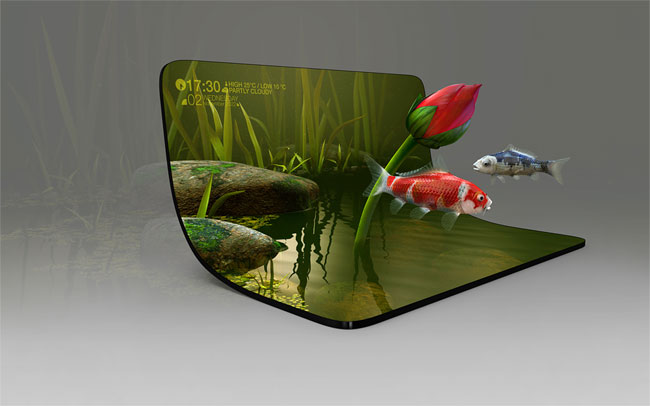
Many companies research in holographic technology and many different kinds of holographic concepts have been dreamt up. Concept: ihamid, CGsociety
One of the most promising technologies is holography. Holographic display concepts already exist but often inside controlled environments. The vision is to turn reality into a holographic environment. Make things appear next to us. People, objects etc. But none of these technologies are even close to being consumer-ready concepts. In addition, the absence of content for holographic displays will make it a tough uphill battle. The trend is certainly interesting but do not hold your breath.
Another vision is the so-called Integral 3D. It is an extension of today’s 3D technology that only relies on the 3D depth dimension. What if you could actually make real 3D? If you could move to the side and get a completely different perspective? A Matrix-like effect. Integral 3D already exists as concepts and could be the precursor to holography but it is still mostly a concept.
And those that never made it
5-10 years ago the industry started talking about something called SED TV. You might even remember it. It was Canon whom had developed a great display technology that combined the strengths of LCD and plasma in one technology. Toshiba later teamed up with Canon to bring the products to market.
But SED was delayed several times and hit by lawsuits that practically killed the technology. The patent fight ended in 2008 but in 2010 Canon officially killed SED and with it the promise of amazing picture quality in our living rooms. Sony had a side project called FED that was basically a variant of SED but after Pioneer pulled the TV plug and Panasonic bought Pioneer’s plasma technology and factories that Sony had hoped to use, Sony practically also pulled the plug.
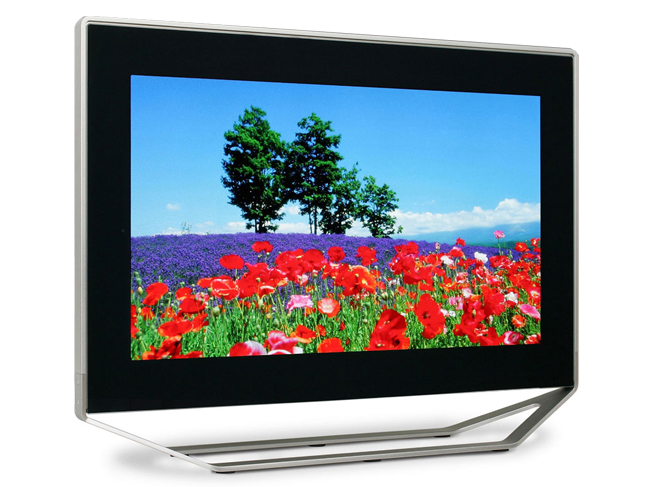
Canon’s SED-TV dream never made it
Another display technology that actually made it out on the market was Mitsubishi's laser display technology. Mitsubishi launched - after several delays - their first laser television in late 2008 under the name LaserVue. However, the TV failed to provide additional value and the bulkiness of the cabinet made it the laughing stock of the TV market in a time when TVs were becoming ultra slim. We have not heard much from Mitsubishi since and they even exited the LCD-TV market in early 2011.
That’s how fast the display industry moves.
Which display technologies do you see greatest potential in? Do you believe in the technologies mentioned here or do you have a different view of the future?
 5 display technologies of the future">
5 display technologies of the future">
